You can be led down the garden path, get off the beaten path or take the path less traveled. Everywhere are references to paths in literature and philosophy. Paths make a garden more interesting, too. Simply by changing the shape of your path or the materials underfoot or adding a focal point at a bend, yours can change the look of your whole garden. Consider some of these ideas to update your path.
On my recent excursions to Strybing Arboretum in Golden Gate Park, Filoli Garden in Woodside and our own Hidden Gardens of Bonny Doon, I fell in love with some of the wonderful paths that I found underfoot.
Every garden path begs you to wonder where does it lead? It's the journey as well as the destination that makes it so alluring. As you walk, the garden should slowly reveal surprises, maybe architectural accent plants appear, a wonderful scent greets you, a distant view opens up or drifts of colorful flowers at the edge beckons you to stop and enjoy the scene.
In the front yard you want a solid path directing visitors from a parking area to the front door. It should be wide enough to accommodate two people walking side by side with interesting views along the way like low walls or plant materials to create a sense of enclosure. You want a person to feel they are walking through a defined space and although you may alter the direction of the entry walk to make it more interesting the purpose of the path is to find the front entry area.
But what about all those other paths that wind around the house and in the back garden? Here's where you can get creative.
Paths can be designed to slow people down. Plan pauses along the way- a widening here, a sitting bench nestled beside a bird feeder there, a beautiful piece of garden art next to a tree with interesting bark or a view of distant mountains. You can route them in ways that direct your sight toward beautiful things and away from compost piles and trash cans. Good paths have entries easy to see and pull you in.
When I design a path in a garden I think about how it will fit into the rest of the landscape and the look of the house. Flagstone, brick or pavers are great for paths you're likely to travel on barefoot. You can soften the path's look by planting low groundcovers between pavers. Allow at least 2" of soil between flagstone or pavers and amend the soil so it won't pack down with foot traffic before planting.
Bark or gravel looks great for natural looking paths and a gently curving path invites you to stroll among the plants. If it leads you to a small circular patio all the better.
How wide should you make an informal path? If you want to soften the edge with low plants, allow 3 1/2 to 4 feet. Small grasses, aromatic herbs, fragrant flowers and colorful foliage plants look natural beside a path.
I've seen articles about creating a garden path in a weekend if you're starting from scratch. You can update one of your existing paths easily, too, in about the same time.
An interesting path I encountered once was created from materials found onsite. Old untreated redwood timbers were cut and installed at an angle every 6 ft or so along a packed decomposed granite path. In between were small pieces of flagstone connected with bands of 2" Mexican black pebbles. The look was interesting and inexpensive to achieve.
Look around your own yard for found items that would give your path that personal touch. Old bricks and broken concrete will find new life and you'll save the expense of having to haul it away.

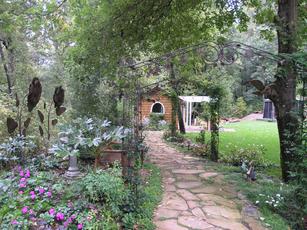
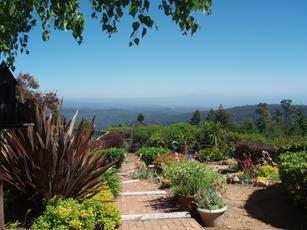
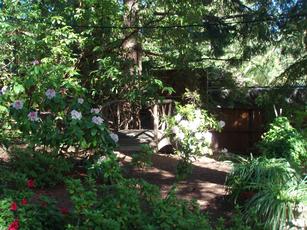
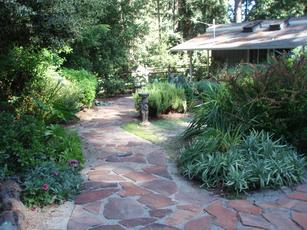
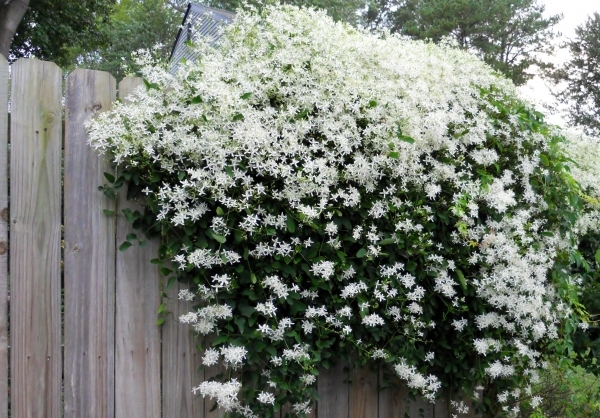 Sweet Autumn Clematis ( clematis terniflora ) and your worries are over. They are a gorgeous sight now covered in pure white, lightly fragrant flowers. Later in the fall the vine will become a silvery mass of fluffy seed heads. This small-flowered species looks impressive covering an upscale arbor or even embellishing a plain fence of garden shed. It blooms on new growth so you can easily keep it in check by cutting stems back to 12" in the spring. It will bloom well in partial shade, too.
Sweet Autumn Clematis ( clematis terniflora ) and your worries are over. They are a gorgeous sight now covered in pure white, lightly fragrant flowers. Later in the fall the vine will become a silvery mass of fluffy seed heads. This small-flowered species looks impressive covering an upscale arbor or even embellishing a plain fence of garden shed. It blooms on new growth so you can easily keep it in check by cutting stems back to 12" in the spring. It will bloom well in partial shade, too. 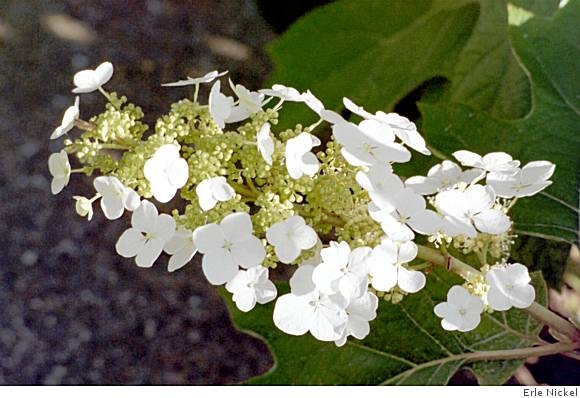 eir huge, whitish-pink conical flowers turn a papery soft tan color. In later autumn, the leaves will take on striking shades of crimson and bronze-purple, and through winter the dry flowers persist above the branches lined with exfoliating copper-brown, cinnamon and tan bark. Oakleaf hydrangeas are fast growing and accept full sun or partial shade in rich evenly moist soil. They’re real lookers in the garden.
eir huge, whitish-pink conical flowers turn a papery soft tan color. In later autumn, the leaves will take on striking shades of crimson and bronze-purple, and through winter the dry flowers persist above the branches lined with exfoliating copper-brown, cinnamon and tan bark. Oakleaf hydrangeas are fast growing and accept full sun or partial shade in rich evenly moist soil. They’re real lookers in the garden. .jpg) Ceanothus ‘Diamond Heights‘. Carpet an area with a dense, low mat of golden yellow and lime-green variegated foliage that looks great year round. The pretty light blue spring flowers take second place to the leaves.
Ceanothus ‘Diamond Heights‘. Carpet an area with a dense, low mat of golden yellow and lime-green variegated foliage that looks great year round. The pretty light blue spring flowers take second place to the leaves. 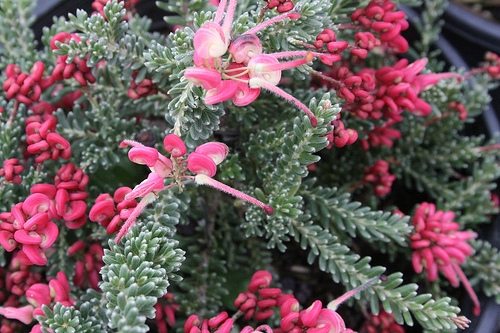
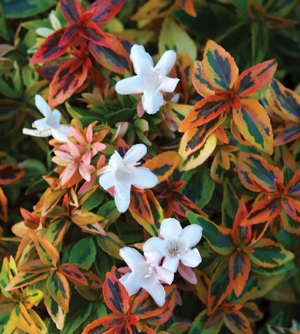 Kaleidescope abelia
Kaleidescope abelia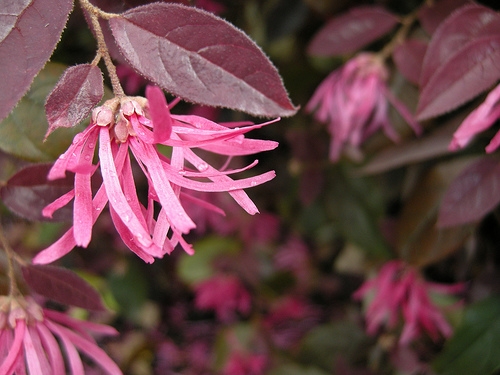 Raspberry flower clusters are heaviest in the spring but some bloom is likely throughout the year. I place this plant in the foreground where you can appreciate it’s graceful shape-looks great as an accent or in a raised bed. The burgundy color can add color to a woodland garden and it even does well in a container on the patio. You can prune it to any size but please don’t turn it into a tight ball and ruin it’s shape. Another plus is that it is not attractive to deer.
Raspberry flower clusters are heaviest in the spring but some bloom is likely throughout the year. I place this plant in the foreground where you can appreciate it’s graceful shape-looks great as an accent or in a raised bed. The burgundy color can add color to a woodland garden and it even does well in a container on the patio. You can prune it to any size but please don’t turn it into a tight ball and ruin it’s shape. Another plus is that it is not attractive to deer. 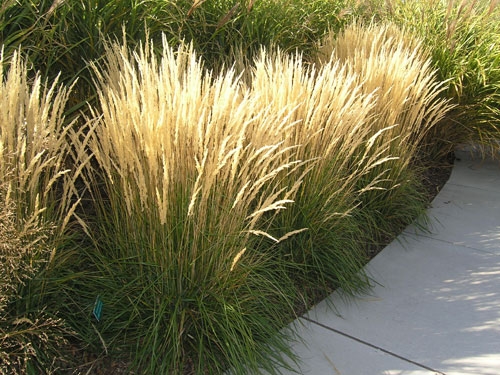 Karl Foerster feather reed grass adds a vertical element to your summer and fall garden. It provides wonderful contrast among low shrubs and perennials. Named after the famous landscape architect and photographer with a love for all aspects of perennial plants, Karl Foerster lived in Germany from 1874 to 1970. This grass won the 2001 Perennial Plant of the Year and although it’s not new on the market it’s an easy to grow ornamental grass that won’t overpower your space.
Karl Foerster feather reed grass adds a vertical element to your summer and fall garden. It provides wonderful contrast among low shrubs and perennials. Named after the famous landscape architect and photographer with a love for all aspects of perennial plants, Karl Foerster lived in Germany from 1874 to 1970. This grass won the 2001 Perennial Plant of the Year and although it’s not new on the market it’s an easy to grow ornamental grass that won’t overpower your space. 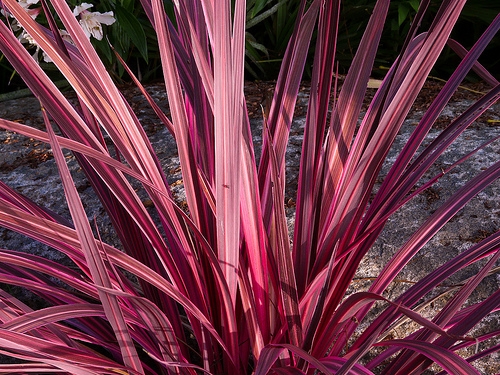
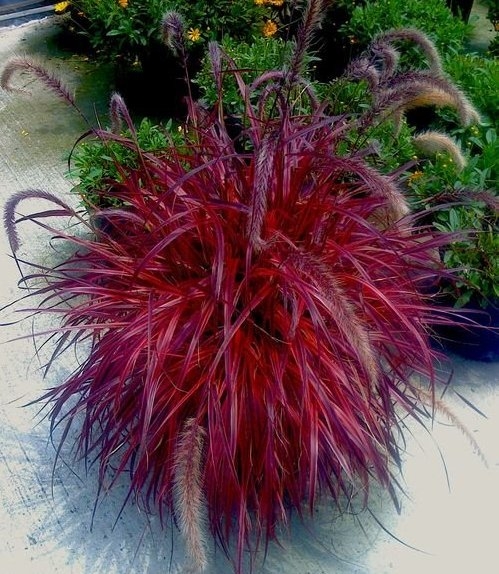 Pennisetum Fireworks
Pennisetum Fireworks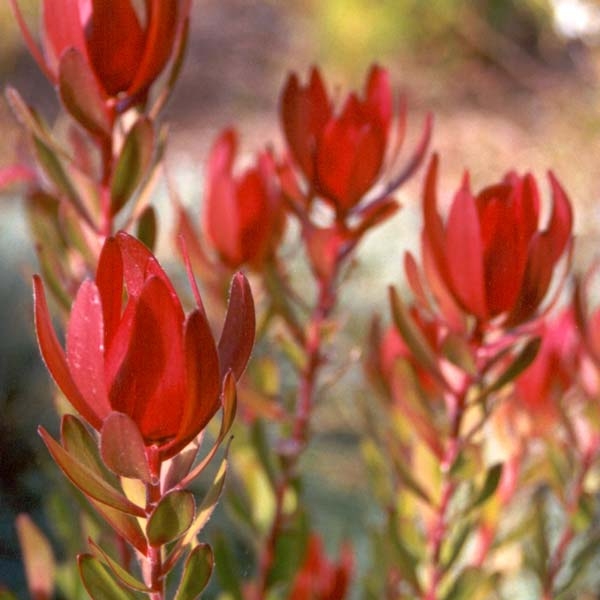 pular Leaucadendron available. It’s a vigorous, erect grower to over 8 feet tall and tough enough to handle frost and clay soils. The flower is actually an insignificant cone surrounded by large colorful bracts which are excellent for cut foliage harvesting.
pular Leaucadendron available. It’s a vigorous, erect grower to over 8 feet tall and tough enough to handle frost and clay soils. The flower is actually an insignificant cone surrounded by large colorful bracts which are excellent for cut foliage harvesting. 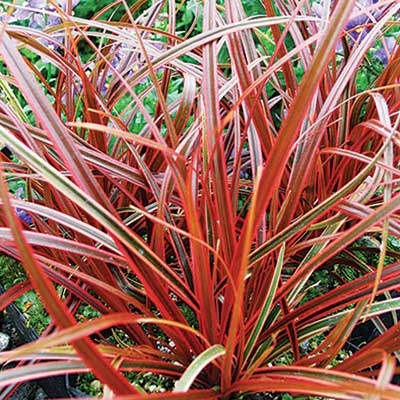
 Euphorbia Diamond Frost blooms continuously with clouds of white flowers that float above finely textured apple-green foliage. This delicate looking perennial may be small in stature, reaching 12-18 " tall and wide, but is easy to grow and surprisingly tolerant of drought and heat. Combine this airy plant with bright colors for a dazzling border.
Euphorbia Diamond Frost blooms continuously with clouds of white flowers that float above finely textured apple-green foliage. This delicate looking perennial may be small in stature, reaching 12-18 " tall and wide, but is easy to grow and surprisingly tolerant of drought and heat. Combine this airy plant with bright colors for a dazzling border.  occasional to regular irrigation. This strong color combination of green and pink doesn’t revert to the parent plants coloring. It’s hardy to 15-20 degrees. You might find this plant also listed as Jubilee.
occasional to regular irrigation. This strong color combination of green and pink doesn’t revert to the parent plants coloring. It’s hardy to 15-20 degrees. You might find this plant also listed as Jubilee. 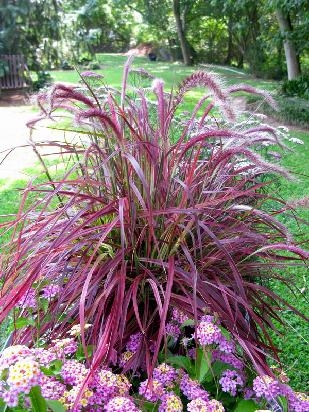 . Some are already being grown on a limited basis by the wholesale growers while others won’t become available until 2011. Recently I had the opportunity to view up-close and personal some of these new unique perennials, shrubs and grasses. It’s exciting to envision these in our own gardens.
. Some are already being grown on a limited basis by the wholesale growers while others won’t become available until 2011. Recently I had the opportunity to view up-close and personal some of these new unique perennials, shrubs and grasses. It’s exciting to envision these in our own gardens.